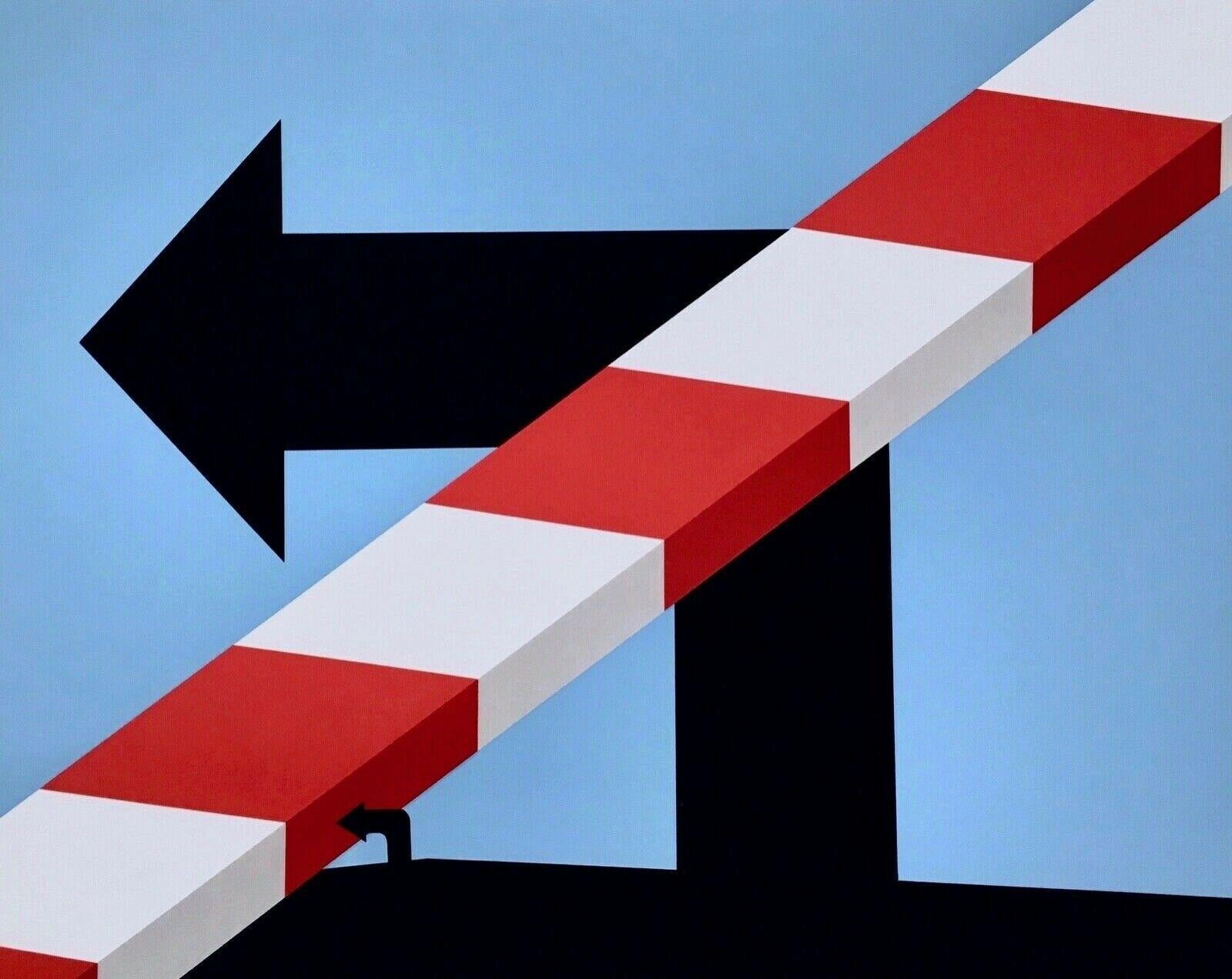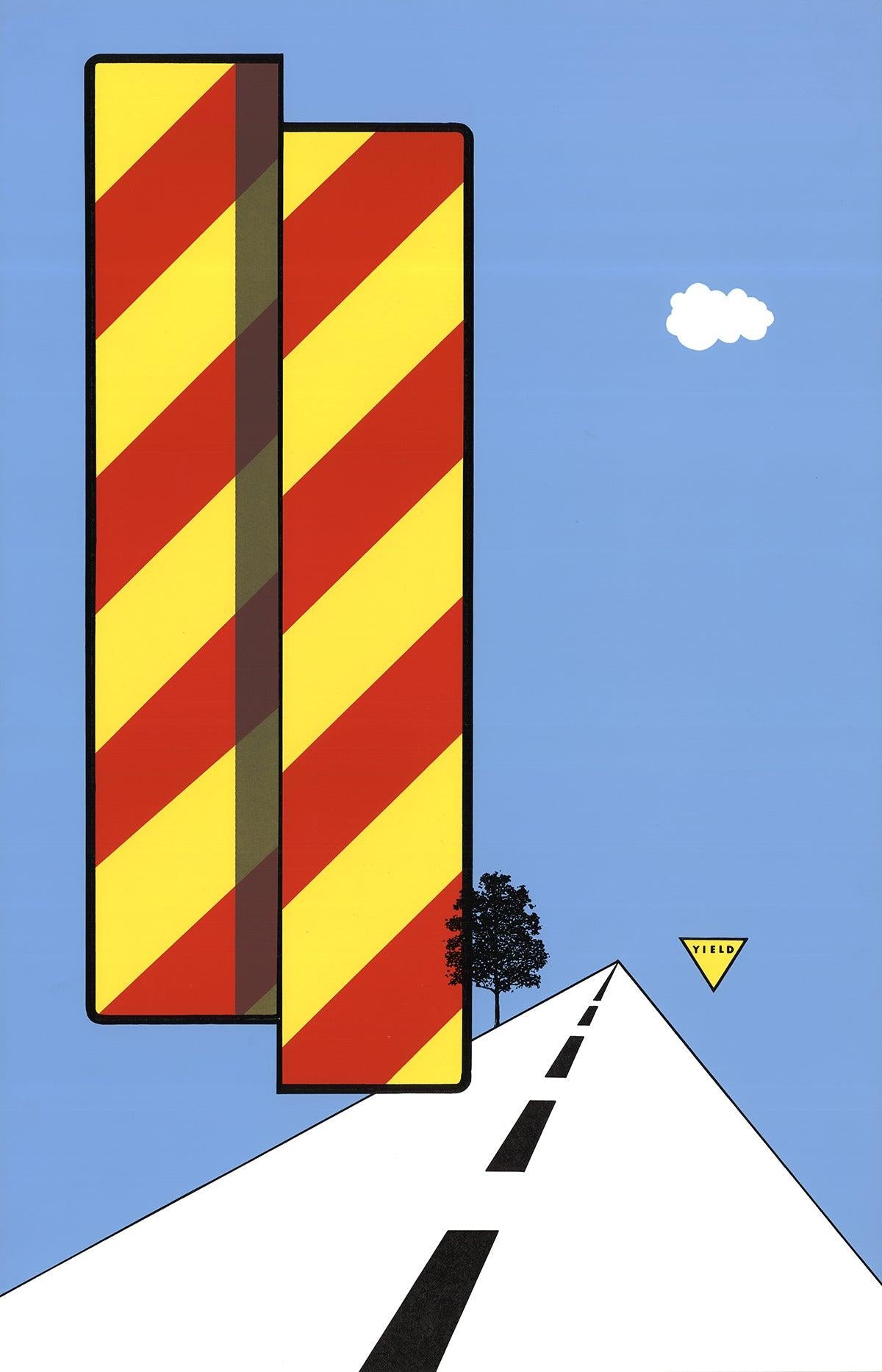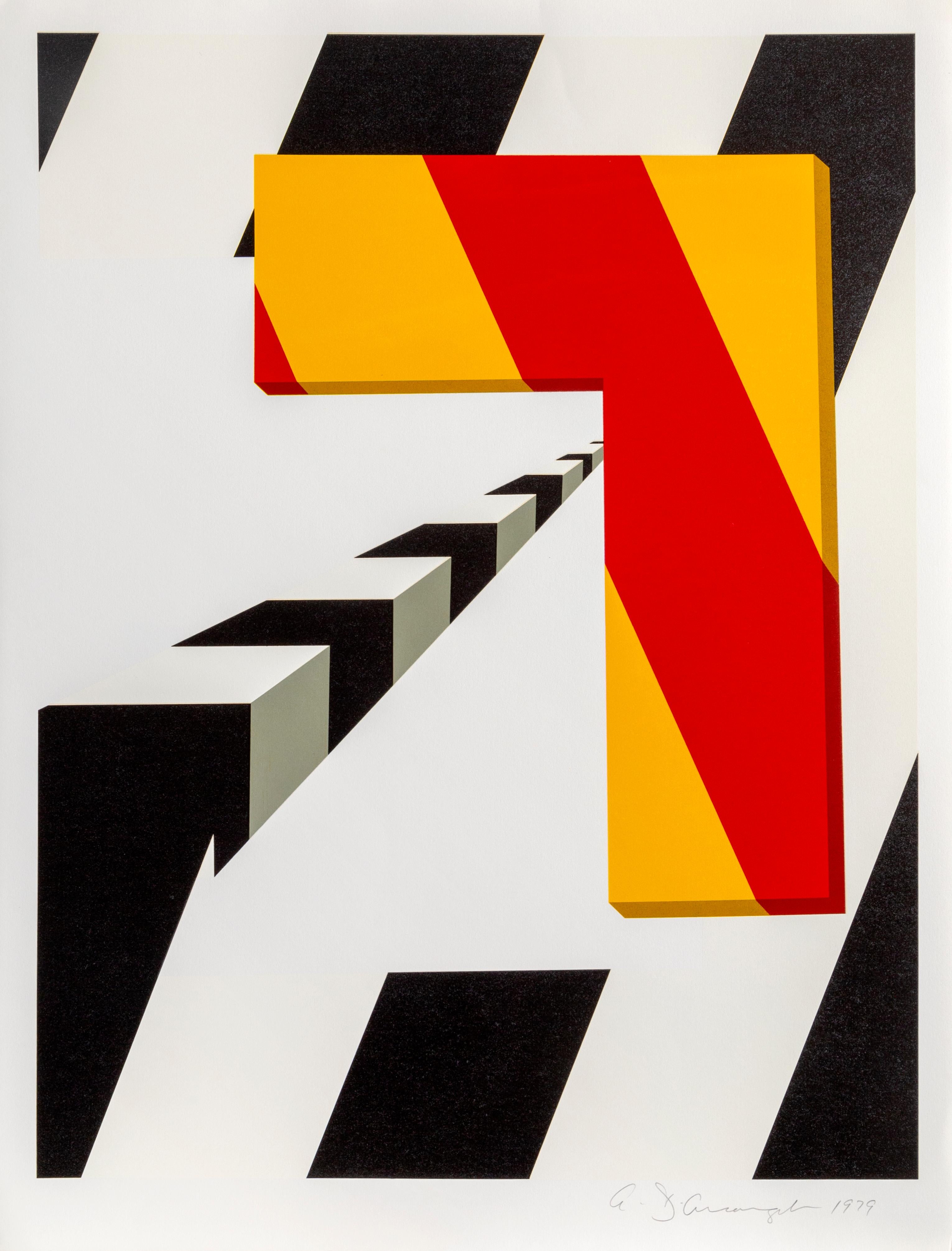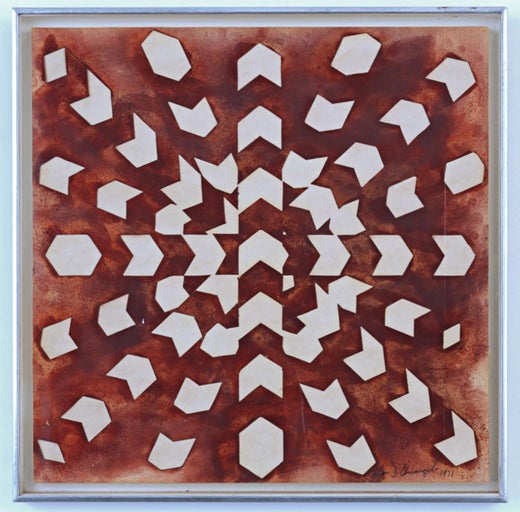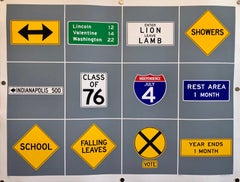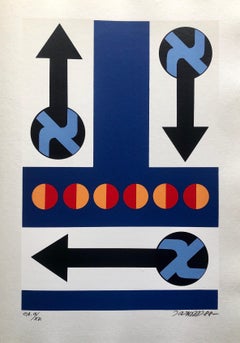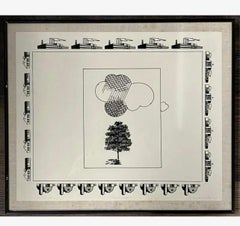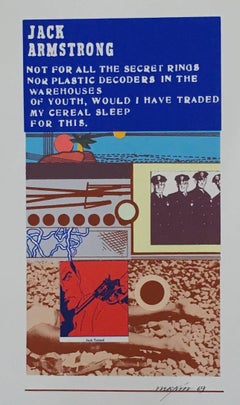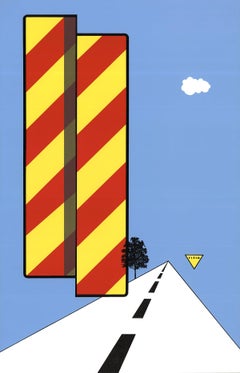Items Similar to Pop Art Aspen Road Sign D'arcangelo Silkscreen Chiron Press Vintage Art Poster
Want more images or videos?
Request additional images or videos from the seller
1 of 10
Allan D'Arcangelo Pop Art Aspen Road Sign D'arcangelo Silkscreen Chiron Press Vintage Art Poster1967
1967
$1,500
£1,134.85
€1,309.80
CA$2,095.08
A$2,329.33
CHF 1,219.26
MX$28,568.48
NOK 15,524.32
SEK 14,656.80
DKK 9,774.13
Shipping
Retrieving quote...The 1stDibs Promise:
Authenticity Guarantee,
Money-Back Guarantee,
24-Hour Cancellation
About the Item
Allan D'Arcangelo (American/New York, 1930-1998),
"Aspen Center of Contemporary Art",
1967
silkscreen, hand signed in pencil, dated, numbered "45/200" and blind stamped "Chiron Press, New York, NY"
32 in. x 24 in.
Allan D'Arcangelo (1930-1998) was an American artist and printmaker, best known for his paintings of highways and road signs that border on pop art and minimalism, precisionism, Abstract illusionism and hard-edge painting, and also surrealism. His subject matter is distinctly American and evokes, at times, a cautious outlook on the future of this country. Allan D'Arcangelo was the son of Italian immigrants. He studied at the University of Buffalo from 1948–1953, where he got his bachelor's degree in history. After college, he moved to Manhattan and picked up his studies again at the New School of Social Research and the City University of New York, City College. At this time, he encountered Abstract Expressionist painters who were in vogue at the moment. After joining the army in the mid 1950s, he used the GI Bill to study painting at Mexico City College from 1957–59, driving there over 12 days in an old bakery truck retrofitted as a camper. However, he returned to New York in 1959, in search of the unique American experience. It was at this time that his painting took on a cool sensibility reminiscent of Roy Lichtenstein and Andy Warhol. His interests engaged with the environment, anti-Vietnam War protests, and the commodification and objectification of female sexuality. D'Arcangelo first achieved recognition in 1962, when he was invited to contribute an etching to The International Anthology of Contemporary Engraving: America Discovered; his first solo exhibition came the next year, at the Thiebaud Gallery in New York City. In 1965 he contributed three screenprints to Original Edition's 11 Pop Artists portfolio. By the 1970s, D'Arcangelo had received significant recognition in the art world. He was well known for his paintings of quintessentially American highways and infrastructure, and in 1971 was commissioned by the Department of the Interior to paint the Grand Coulee Dam in Washington state. However, his sense of morality always trumped his interest in art world fame. In 1975, he decided to quit the gallery that had been representing him for years, Marlborough Gallery, because of the way they handled Mark Rothko legacy.
D'Arcangelo rejected Abstract Expressionism, though his early work has a painterly and somewhat expressive feel. He quickly turned to a style of art that seemed to border on Pop Art and Minimalism, Precisionism and Hard-Edge painting. Evidently, he didn't fit neatly in the category of Pop Art, though he shared subjects (women, signs, Superman) and techniques (stencil, assemblage) with these artists.He turned to expansive, if detached scenes of the American highway. These paintings are reminiscent of Giorgio de Chirico-though perhaps not as interested in isolation-and Salvador Dali-though there is a stronger interest in the present and disinterest in the past. These paintings also have a sharp quality that is reminiscent of the precisionist style, or more specifically, Charles Sheeler. 1950s, Before D'Arcangelo returned to New York, his style was roughly figurative and reminiscent of folk art. During the early 1960s, Allan D'Arcangelo was linked with Pop Art. "Marilyn" (1962) depicts an illustrative head and shoulders on which the facial features are marked by lettered slits to be "fitted" with the eyebrows, eyes, nose and mouth which appear off to the right in the composition. In "Madonna and Child," (1963) the featureless faces of Jackie Kennedy and Caroline are ringed with haloes, enough to make their status as contemporary icons perfectly clear.
Select Exhibitions:
Fischbach Gallery, New York,
Ileana Sonnabend Gallery, Paris,
Gallery Müller, Stuttgart, Germany
Hans Neuendorf Gallery, Hamburg, Germany
Dwan Gallery, Los Angeles
Galerie Ricke, Kassel, Germany,
Obelisk Gallery, Boston,
Minami Gallery, Tokyo,
Württembergischer Kunstverein, Stuttgart, Germany
Lambert Gallery, Paris
Albright-Knox Art Gallery, Buffalo,
Museum of Contemporary Art, Chicago,
Marlborough GalleryPatricia Moore Gallery, Aspen, Colorado
Hokin Gallery, Chicago
Grace Borgenicht Gallery,
Retrospettiva, Palazzina dei Giardini, Modena, Italy
Mitchell Innes & Nash,
Beyond Pop: Allan D'Arcangelo, Hollis Taggart Galleries,
Garth Greenan Gallery, New York,
Pi in the Sky, Waddington Custot, London, UK,
Select Group Exhibitions
Allan D'Arcangelo: Bilder und John Chamberlain: Plastiken, Galerie Rudolf Zwirner, Arakawa, Allan D'Arcangelo, Mark di Suervo, Robert Grosvenor, Anthony Magar, Neil Williams, Dwan Gallery, Los Angeles,
American Painting Now, ACA Gallery, Boston
Contemporary Drawings, New York University
Pop Art Americana: D'Arcangelo, Jim Dine, Kelly, Lichtenstein, Claes Oldenburg, Phillips, Mel Ramos, James Rosenquist, George Segal, Warhol, John Wesley, Tom Wesselman, Galleria De' Foscherari, Bologna, Italy
Frank O'Hara / In Memory of My Feelings, Museum of Modern Art, New York,
Annual Exhibition of Contemporary American Painting Whitney Museum of American Art
Beyond Literalism: An Exhibition of Painting and Sculpture by Allan D'Arcangelo, Charles Fahlen, Jack Krueger, Naoto Nakagawa, Frank Roth, William Schwedler, William Wiley, Guggenheim Museum of Art, New York,
Fotos Aus Der Kunstszene New York, Kunstmuseum Düsseldorf,
Artists Salute Skowhegan, Kennedy Gallery, New York,
Contemporary American Art, Minneapolis Institute of Art, Minnesota
From 1963 to 1968, Chiron Press was the ground-zero of the fledgling Pop Art scene. Founded in a tiny storefront on 614 East 11th Street in New York City, it was the first print atelier in New York City, indeed in the country, devoted to screen printing for artists. Andy Warhol, Roy Lichtenstein, James Rosenquist and Claes Oldenburg made silkscreen prints at Chiron. Alfred Jensen, Valerie Jaudon made early prints there. Chiron Press also worked with many female artists, including Marisol, Elaine DeKooning Louise Nevelson and Helen Frankenthaler.
- Creator:Allan D'Arcangelo (1930 - 1998, American)
- Creation Year:1967
- Dimensions:Height: 32 in (81.28 cm)Width: 24 in (60.96 cm)
- Medium:
- Movement & Style:
- Period:
- Condition:mounted to backing, minor wear at extreme edges. please see photos.
- Gallery Location:Surfside, FL
- Reference Number:1stDibs: LU38214305582
undefined
About the Seller
4.9
Platinum Seller
Premium sellers with a 4.7+ rating and 24-hour response times
Established in 1995
1stDibs seller since 2014
1,780 sales on 1stDibs
Typical response time: <1 hour
- ShippingRetrieving quote...Shipping from: Surfside, FL
- Return Policy
Authenticity Guarantee
In the unlikely event there’s an issue with an item’s authenticity, contact us within 1 year for a full refund. DetailsMoney-Back Guarantee
If your item is not as described, is damaged in transit, or does not arrive, contact us within 7 days for a full refund. Details24-Hour Cancellation
You have a 24-hour grace period in which to reconsider your purchase, with no questions asked.Vetted Professional Sellers
Our world-class sellers must adhere to strict standards for service and quality, maintaining the integrity of our listings.Price-Match Guarantee
If you find that a seller listed the same item for a lower price elsewhere, we’ll match it.Trusted Global Delivery
Our best-in-class carrier network provides specialized shipping options worldwide, including custom delivery.More From This Seller
View AllPop Art 1970s Vintage Silkscreen Screen Print Street Signs Titled Calendar
By Paul M. Levy
Located in Surfside, FL
Printed on heavy Strathmore paper.
Paul Levy (American, b. 1944) An established designer and illustrator, Paul M. Levy was born in Brooklyn, New York, in 1944. He received his B.S. i...
Category
1970s Abstract Geometric Abstract Prints
Materials
Screen
Hungarian Surrealism Pop Art Hebrew Silkscreen Judaica Print Jewish Serigraph
By Jozsef Jakovits
Located in Surfside, FL
Abstract Hebrew Prints on heavy mould made paper from small edition of 15. there is a facing page of text in Hungarian folded over. Hard edged geometric abstract prints in color base...
Category
1980s Pop Art Abstract Prints
Materials
Archival Paper, Screen
Rare Original 1967 Minimalist Mod Pop Art Allan D'Arcangelo Unique Ink Drawing
Located in Surfside, FL
Allan D'Arcangelo (American/New York, 1930-1998),
1967 Cloud and Tree
Note affixed to back
Frame: 16 X 19
Image: 14 X 17
Hand signed in pencil and dated lower right 1967, titled bot...
Category
1960s Pop Art Landscape Drawings and Watercolors
Materials
Paper, Ink
Epitaph/Tombstone jack Armstrong Pop Art 1969 Color Screenprint Richard Merkin
By Richard Merkin
Located in Surfside, FL
Poetry by J.D. REED Artwork by Richard Merkin screenprint in color, 1969, edition 22/50 Published by Bizzaro, Providence, R.I.
Richard Marshall Merkin (1938-2009) was an American painter, illustrator and arts educator. Merkin's fascination with the 1920s and 1930s defined his art and shaped his identity as a professional dandy. Merkin traveled back in time as an artist, to the time of the interwar years, creating narrative scenes (ala Robert Crumb and Ben Katchor) in bright colors of jazz musicians, film stars, writers, and sports heroes. Merkin was as well known for his painting and illustration work as he was for his eccentric collecting habits and his outré fashion sense. he received a Louis Comfort Tiffany Foundation Fellowship in Painting.
Merkin began teaching at the Rhode Island School of Design (RISD) in 1963 and remained there for 42 years, during which time he built his reputation in New York. Some notable students Merkin taught at RISD include Chris Frantz and Tina Weymouth of the band Talking Heads and Martin Mull.
Merkin had been a contributing editor for Vanity Fair since 1986 and a regular contributor of illustrations to The New Yorker since 1988, as well as Harper's and The New York Times' Sunday Magazine. From 1988–1991, he wrote a monthly style column called "Merkin on Style" for Gentlemen's Quarterly.
Merkin also designed several album covers for the Jazz record label Chiaroscuro Records for artists such as Mary Lou Williams, Ruby Braff, and Ellis Larkins.
Merkin's friend, the writer Tom Wolfe wrote in an email to the New York Times upon Merkin's death:
"He was the greatest of that breed, the Artist Dandy, since Sargent, Whistler and Salvador Dali, Like Dali, he had one of the few remaining Great Mustaches in the art world" Perpetually on the fly from his middle-class Brooklyn background, Merkin found the perfect escape in the mid ‘60s in George Frazier, a dapper Boston columnist who inspired the emerging New York painter’s overnight reinvention of himself. The elements of structure, stability and surprise he admired in this well-dressed dandy, a cool linen suit, a splash of suspender, a polka dot scarf and pearl-handled walking stick, soon surfaced in paintings peopled by impeccable underdogs of café society along with his personal pop heroes, William Burroughs, Bobby Short...
Category
1960s Pop Art Abstract Prints
Materials
Screen
Deborah Kass Feminist Jewish American Pop Art Silkscreen Screenprint Ltd Edition
By Deborah Kass
Located in Surfside, FL
Deborah Kass (born 1952)
Limited edition geometric abstract lithograph in colors on artist paper.
Hand signed and dated in pencil to lower right. 1973.
Edition: 102/120 to lower left.
Dimensions: sight: 16-3/4" W x 21-1/4" H. Frame: 24-5/8" W x 28-7/8" H.
Finding inspiration in pop culture, political realities, film, Yiddish, art historical styles, and prominent art world figures, Deborah Kass uses appropriation in her work to explore notions of identity, politics, and her own cultural interests. She received her BFA in painting at Carnegie Mellon University and studied at the Whitney Museum Independent Study Program and the Art Students League of New York.
Deborah Kass (born 1952) is an American artist whose work explores the intersection of pop culture, art history, and the construction of self. Deborah Kass works in mixed media, and is most recognized for her paintings, prints, photography, sculptures and neon lighting installations. Kass's early work mimics and reworks signature styles of iconic male artists of the 20th century including Frank Stella, Andy Warhol, Jackson Pollock, and Ed Ruscha. Kass's technique of appropriation is a critical commentary on the intersection of social power relations, identity politics, and the historically dominant position of male artists in the art world.
Deborah Kass was born in 1952 in San Antonio, Texas. Her grandparents were from Belarus and Ukraine, first generation Jewish immigrants to New York. Kass's parents were from the Bronx and Queens, New York. Her father did two years in the U.S. Air Force on base in San Antonio until the family returned to the suburbs of Long Island, New York, where Kass grew up. Kass’s mother was a substitute teacher at the Rockville Centre public schools and her father was a dentist and amateur jazz musician.
At age 14, Kass began taking drawing classes at The Art Students League in New York City which she funded with money she made babysitting. In the afternoons, she would go to theater on and off Broadway, often sneaking for the second act. During her high school years, she would take her time in the city to visit the Museum of Modern Art, where she would be exposed to the works of post-war artists like Frank Stella and Willem De Kooning. At age 17, Stella’s retrospective exhibition inspired Kass to become an artist as she observed and understood the logic in his progression of works and the motivation behind his creative decisions.
Kass received her BFA in Painting at Carnegie Mellon University (the alma mater of artist Andy Warhol), and studied at the Whitney Museum Independent Study Program Here, she created her first work of appropriation, Ophelia’s Death After Delacroix, a six by eight foot rendition of a small sketch by the French Romantic artist, Eugène Delacroix.
At the same time Neo-Expressionism was being helmed by white men in the late Reagan years, women were just beginning to create a stake in the game for critical works. “The Photo Girls...
Category
2010s Pop Art Figurative Prints
Materials
Screen
1970's Large Silkscreen Abstract Geometric Day Glo Serigraph Pop Art Print Neon
By Chryssa Vardea-Mavromichali
Located in Surfside, FL
Silkscreen on Arches paper, Hand signed and Numbered in Pencil. Serigraph in black, gray (silver).
Chryssa Vardea-Mavromichali (Greek: Χρύσα Βαρδέα-Μαυρομιχάλη; December 31, 1933 – December 23, 2013) was a Greek American artist who worked in a wide variety of media. An American art pioneer in light art and luminist sculpture widely known for her neon, steel, aluminum and acrylic glass installations, she has always used the mononym Chryssa professionally. She worked from the mid-1950s in New York City studios and worked since 1992 in the studio she established in Neos Kosmos, Athens, Greece.
Chryssa was born in Athens into the famous Mavromichalis family from the Mani Peninsula. one of her sisters, who studied medicine, was a friend of the poet and novelist Nikos Kazantzakis.
Chryssa began painting during her teenage years and also studied to be a social worker.In 1953, on the advice of a Greek art critic, her family sent her to Paris to study at the Académie de la Grande Chaumiere where Andre Breton, Edgard Varese, and Max Ernst were among her associates and Alberto Giacometti was a visiting professor.
In 1954, at age twenty-one, Chryssa sailed for the United States, arrived in New York and went to San Francisco, California to study at the California School of Fine Arts. Returning to New York in 1955, she became a United States citizen and established a studio in the city.
Chryssa's first major work was The Cycladic Books preceded American minimalism by seventeen years.
1961, Chryssa's first solo exhibition was mounted at The Guggenheim.
1963, Chryssa's work was shown at the Museum of Modern Art in curator Dorothy Canning Miller's Americans 1963 exhibition. The artists represented in the show also included Richard Anuszkiewicz, Lee Bontecou, Robert Indiana, Richard Lindner, Marisol, Claes Oldenburg, Ad Reinhardt, James Rosenquist and others.
1966, The Gates to Times Square, regarded as "one of the most important American sculptures of all time" and "a thrilling homage to the living American culture of advertising and mass communications." The work is a 10 ft cube installation of two huge letter 'A's through which visitors may walk into "a gleaming block of stainless steel and Plexiglas that seems to quiver in the play of pale blue neon light" which is controlled by programmed timers. First shown in Manhattan's Pace Gallery, it was given to the Albright-Knox Art Gallery in Buffalo, New York in 1972.
1972, The Whitney Museum of American Art mounted a solo exhibition of works by Chryssa.
That's All (early 1970s), the central panel of a triptych related to The Gates of Times Square, was acquired by the Museum of Modern Art between 1975 and 1979.
1973, Chryssa's solo exhibition at the Gallerie Denise René was reviewed for TIME magazine by art critic Robert Hughes before it went on to the Galleries Denise René in Düsseldorf and Paris.
Other works by Chryssa in composite honeycomb aluminum and neon in the 1980s and 1990s include Chinatown, Siren, Urban Traffic, and Flapping Birds.
Chryssa 60/90 retrospective exhibition in Athens in the Mihalarias Art Center. After her long absence from Greece, a major exhibition including large aluminum sculptures - cityscapes, "neon boxes" from the Gates to the Times Square, paintings, drawings etc. was held in Athens.
In 1992, after closing her SoHo studio, which art dealer Leo Castelli had described as "one of the loveliest in the world," Chryssa returned to Greece. She found a derelict cinema which had become a storeroom stacked with abandoned school desks and chairs, behind the old Fix Brewery near the city center in Neos Kosmos, Athens. Using the desks to construct enormous benches, she converted the space into a studio for working on designs and aluminum composite honeycomb sculptures...
Category
1980s Pop Art Abstract Prints
Materials
Screen
You May Also Like
Forever Chic, Geometric Pop Art Screenprint by Allan D'Arcangelo
By Allan D'Arcangelo 1
Located in Long Island City, NY
Artist: Allan D'Arcangelo, American (1930 - 1998)
Title: Forever Chic
Year: 1979
Medium: Screenprint, signed and numbered in pencil
Edition: AP 15/25
Image Size: 40 x 28 inches
Size...
Category
1970s Pop Art More Prints
Materials
Screen
U.S. Highway #1, Allan D'Arcangelo
Located in Fairfield, CT
Artist: Allan D’Arcangelo (1930-1998)
Title: U.S. Highway #1
Year: 1978
Edition: 110/150, plus proofs
Medium: Silkscreen on Arches paper
Size: 26 x 30.25 inches
Condition: Good
Inscr...
Category
1970s Pop Art Abstract Prints
Materials
Screen
$1,036 Sale Price
20% Off
Proposition, Pop Art Screenprint by Allan D'Arcangelo
By Allan D'Arcangelo 1
Located in Long Island City, NY
Artist: Allan D'Arcangelo (American, 1930-1998)
Title: Proposition
Year: 1978
Medium: Screenprint, signed and numbered in pencil
Edition: 150
Size: 30 in. x 26 in. (76.2 cm x 66.04 cm)
Category
1970s Pop Art Abstract Prints
Materials
Screen
Yield
By Allan D'Arcangelo 1
Located in Brooklyn, NY
"Yield" by Allan D’Arcangelo uses the familiar road sign as a symbol of caution and submission, reflecting themes of modern life, societal control, and decision-making. The yield sig...
Category
1960s Pop Art Figurative Prints
Materials
ABS, Screen
Left Turn, Screenprint by Allan D'Arcangelo
By Allan D'Arcangelo 1
Located in Long Island City, NY
Pop art Screenprint by American artist Allan D'Arcangelo.
Date: 1979
Medium: Screenprint, signed and numbered in pencil
Edition: 175
Size: 34 x 26 in. (86.36 x 66.04 cm)
Category
1970s Pop Art Abstract Prints
Materials
Screen
The Holy Family, Pop Art Screenprint by Allan D'Arcangelo
By Allan D'Arcangelo 1
Located in Long Island City, NY
Artist: Allan D'Arcangelo, American (1930 - 1998)
Title: The Holy Family
Year: 1980
Medium: Screenprint, signed and numbered in pencil
Edition: 250
I...
Category
1970s Pop Art Landscape Prints
Materials
Screen
More Ways To Browse
Art Precisionism
Vintage Road Signs
1967 Ring
Bakery Art
Vintage Highway Signs
Vintage Anti War Posters
Jim Dine Lithograph
Pop Art Mel Ramos
Original Mexican Posters
Salvador Dali Signed 1975
George Washington Engraving
Vogue Poster
1965 Salvador Dali Prints
1968 Salvador Dali Signed Print
Warhol Jackie
George Allan Art
Andy Warhol Jackie
Salvador Dali Head
